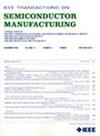Pioneering Fast and Safe Low-k Silicon Dioxide Synthesis for Modern Integrated Circuits
IF 2.3
3区 工程技术
Q2 ENGINEERING, ELECTRICAL & ELECTRONIC
引用次数: 0
Abstract
With the advent of the highly developed era of 5G, AI, and IoT, the latest generation of ICs is designed with smaller-sized FETs, lower time delays, and reduced power consumption. To address the challenges posed by these advancements, materials with a lower k value than silicon dioxide (low-k, <4.0) are being developed to reduce resistance-capacitance (RC) time delays and power consumption. While low-k materials are still emerging, various material companies continue to introduce innovative low-k products, such as SiLK, Fox, Coral, and Aurora from different companies. Simultaneously, considering proprietary business interests, the processes and materials associated with these products have not been clearly presented. In this report, we employ a novel set of equipment to validate an innovative formulation for synthesizing a low-k silicon dioxide layer. Thickness measurements confirm a higher deposition rate of silicon dioxide layers, with excellent uniformity observed on 8” wafer. Furthermore, the dielectric constant (k) decreases to 2.35, indicating the production of a great low-k material. Additionally, in the formulation of reactants, we avoid the use of silane and organic silane, contributing to improved safety in the facility and effective control of reactant costs. The results highlight an advantageous option for fabricating interconnect layers in ICs.为现代集成电路开创快速安全的低 k 值二氧化硅合成技术
随着 5G、人工智能和物联网等高度发达时代的到来,最新一代集成电路的设计需要更小尺寸的 FET、更低的时间延迟和更低的功耗。为了应对这些进步带来的挑战,人们正在开发 k 值低于二氧化硅(低 k 值,<4.0)的材料,以减少电阻电容 (RC) 时间延迟和功耗。虽然低 k 值材料仍在不断涌现,但各材料公司仍在不断推出创新的低 k 值产品,如不同公司推出的 SiLK、Fox、Coral 和 Aurora。同时,考虑到专有商业利益,与这些产品相关的工艺和材料还没有得到清晰的介绍。在本报告中,我们采用了一套新型设备来验证合成低 K 值二氧化硅层的创新配方。厚度测量结果表明,二氧化硅层的沉积率更高,在 8" 晶圆上观察到了极佳的均匀性。此外,介电常数(k)降至 2.35,表明生产出了极佳的低 k 材料。此外,在反应物配方中,我们避免了硅烷和有机硅烷的使用,从而提高了设备的安全性,并有效控制了反应物成本。这些结果凸显了制造集成电路互连层的有利选择。
本文章由计算机程序翻译,如有差异,请以英文原文为准。
求助全文
约1分钟内获得全文
求助全文
来源期刊

IEEE Transactions on Semiconductor Manufacturing
工程技术-工程:电子与电气
CiteScore
5.20
自引率
11.10%
发文量
101
审稿时长
3.3 months
期刊介绍:
The IEEE Transactions on Semiconductor Manufacturing addresses the challenging problems of manufacturing complex microelectronic components, especially very large scale integrated circuits (VLSI). Manufacturing these products requires precision micropatterning, precise control of materials properties, ultraclean work environments, and complex interactions of chemical, physical, electrical and mechanical processes.
 求助内容:
求助内容: 应助结果提醒方式:
应助结果提醒方式:


